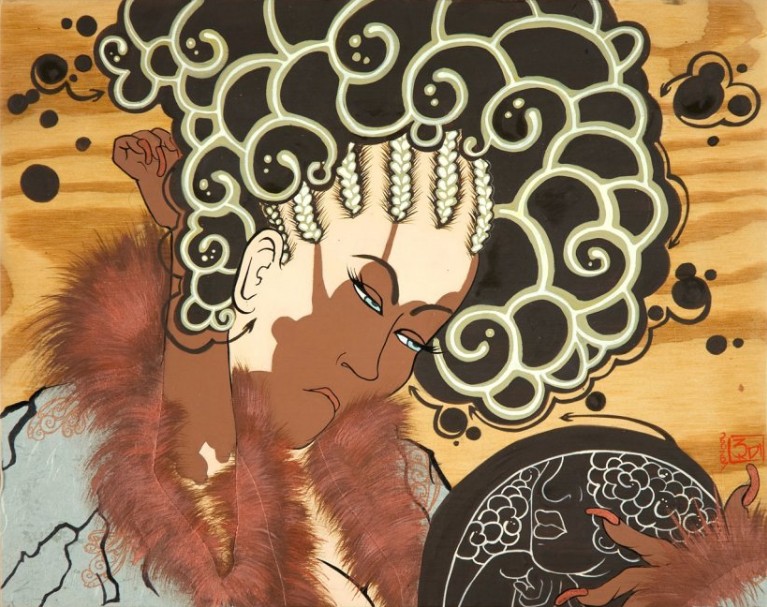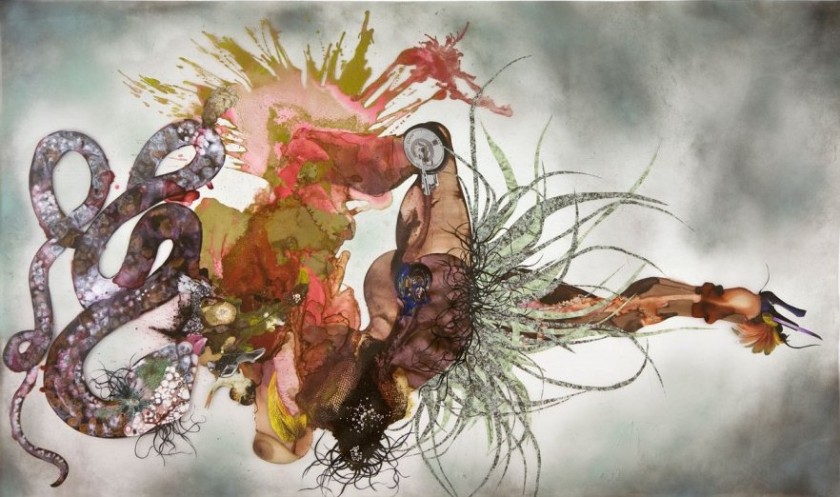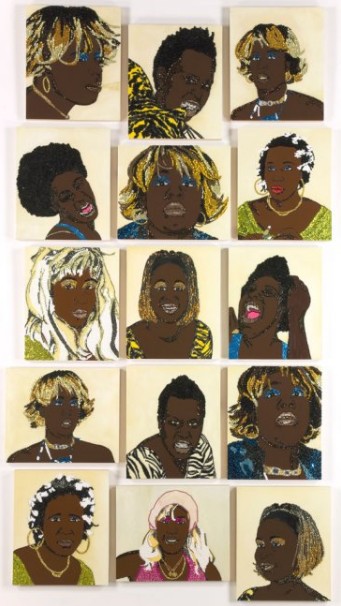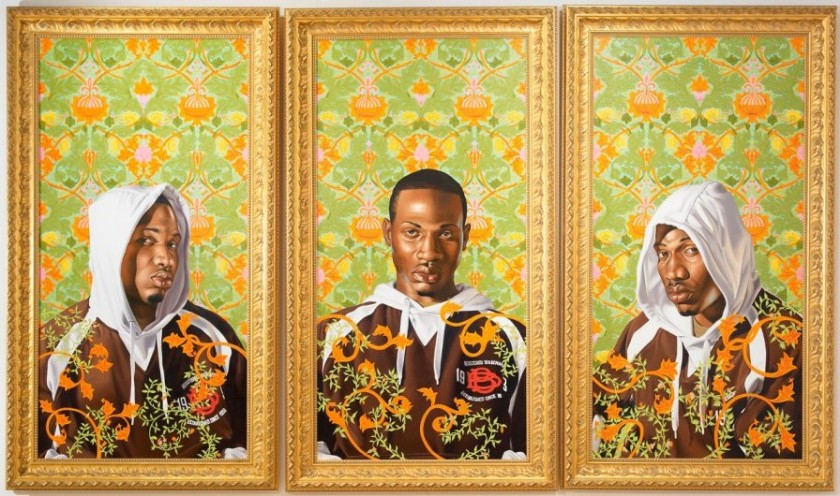The 30 Americans exhibition enters its third week at the North Carolina Museum of Art. I visited it on opening day after attending a museum-hosted debate about: Can there be such a thing as truly black art?, a question I wrote about last week.
The exhibition features 75 works of art from the Rubell Family Collection in Miami by 31 African American artists — 31, not 30, because there was a late addition. The Rubells explain the exhibition name:
“As the show evolved, we decided to call it 30 Americans. “Americans,” rather than “African Americans” or “Black Americans,” because nationality is a statement of fact, while racial identity is a question each artist answers in his or her own way, or not at all.”
My highlights (and other moments), in alphabetical order by artist name:
John Bankston: His three paintings, oil on linen, remind me of coloring books with their heavy black outlines and casual brushstrokes, but they’re not at all childish, on the contrary. The subjects seem mature and fairy tale-like, a bit mysterious. Frankly, I don’t know what’s going on. Is Rehearsal a rehearsal for Midsummer’s Night Dream or a mythological painting come to life? At the Crossroads has that same strangeness: a king in a long robe meets a tree, a tree with a face, perhaps posing one of those life and death riddles, like in Monty Python’s Holy Grail. His paintings captivated me. I wonder what kinds of books the artist reads.
Jean-Michel Basquiat: I was a lot more knowledgeable about the contemporary art scene when Basquiat became a big deal than I am today. I remember reading about his gallery shows and then his museum exhibitions, but I don’t think I ever saw one of his shows in real life. I know everyone raves about him, but his work was a “meh” moment for me. Maybe I need to live with it more. Maybe I’m not feeling in the social commentary mood. Maybe it just wasn’t a Basquiat kind of day.

Iona Rozeal Brown: Love her! Not surprising since I’ve been in a Japanese mood lately. I change my screensavers frequently and the current roster features several Japanese woodblock prints. I fell in love first with Brown’s Sacrifice #2: It Has to Last (after Yoshitoshi’s “Drowsy: the appearance of a harlot of the Meiji era”), a long title for a Japanese woodblock style piece of enamel, acrylic and paper on wooden panel. It’s a portrait of ganguro, a fad I knew nothing about — Japanese teens emulating African Americans, geisha meets hip-hop. I love that the woman’s acrylic nails match her hair sash. A beautiful piece, both delicate and in-your-face. Her other, Untitled (after Kikugawa Eizan’s “Furyu nana komachi” [The Modern Seven Komashi]), is also a beautiful acrylic and paper on wooden panel. Eizan was a Japanese printmaker in the 1800’s famous for his portraits of beautiful women, including many from the “pleasure quarters.” I bet he too would love her work.
Nick Cave: His four Soundsuits are a joy, so different from everything else in the exhibition. The first one you see upon entering is the one that NCMA is using as their profile photo on Facebook, a wedding centerpiece Woodstockian get-up. Get up close and look at the detail on these suits. I wonder if he ever made clothes for his friends. The colored hair suit reminds me of a Saturday morning cartoon. A video from the Seattle Art Museum shows what these suits look like in their full glory – dancing around.
Robert Colescott: You’re hit with the bold colors of Colescott’s three paintings when you walk into this gallery, particularly in contrast to the other work in the room. There’s a lot going on in these pieces. I wish Colescott was there to walk me through each one. Arabs has references to Arabs as past dealers of slaves and current dealers of oil, along with images of slaves in chains, flags, military officer, oil barrels and bananas. I thought of our nation’s dependency on these “exports” then and now. Sphinx Speaks made me wonder, “Who’s the Sphinx now? Should you listen?” And Pygmalion made me think about the ideals we all strive for. His style didn’t do much for me but I liked how he provoked me into wondering about his message.
Glenn Ligon: Some art appeals to me first in a visual way, some in an intellectual way. Ligon’s does the latter but I enjoy his technique too. It’s the kind of art that makes more sense once you read the wall label explaining his inspiration, usually literary in this exhibition. I Sell the Shadow to Sustain the Substance is installed so the black backing of the neon light display is facing the viewer, and the glare (or shadow) of the light is cast upon the wall. His inspiration is a saying that Sojourner Truth printed on her carte-de-visites (calling cards), a commentary on selling art and art as a shadow of the real self, the substance. His two “gold” paintings, Gold When Black Wasn’t Beautiful and Gold Nobody Knew Me display quotes from Richard Pryor. They make you chuckle and reflect at the same time. From far away Stranger looks like a black Ad Reinhardt, but as you get closer you see textures, and then words obscured by black, words (thank you, label) from James Baldwin about being the only black in a Swiss village. It’s Ligon’s quote you see when you enter the exhibition: “We’re always at the mercy of people’s desires to place us in certain identities.”
Rodney McMillan: Untitled. My WTF moment. Don’t get me wrong, I enjoy a good piece of conceptual art as much as the next art fan. I had my epiphany when the Vogel collection was shown years ago at the National Gallery. I loved that exhibit and it opened up a whole new world of art to me. But this is a stained carpet to me, nothing more. At first I figured it was a carpet painted to look like it was stained which would still be odd but would give me a laugh and appreciation for craft. But no, it’s just stained carpet. The label said something about the mystery of not knowing the story or the absence of something, I don’t know. I’m all for wrapping my head around challenging work, but not this time.

Wangechi Mutu: Non Je Ne Regrette Rien. This was the second painting I visited after entering, and the second one that hit a chord with me. I knew then this would be a good day. I loved its gorgeous, diaphanous, warm color washes. Is it animal, woman, both? Yes. I have no idea what’s going on here and I don’t care. Later in the show I also fell for The Evolution of Mud Mama from Beginning to Start, a series of six smaller paintings. More strange beauty, a mix of watercolor and collage with dark rich colors, they seem primordial, maybe symbols of something from our psyche or ancient past.
Lorna Simpson: Wigs (Portfolio). A mix of wig illustration and snippets of text, it looks like a historical museum display, but makes you think about judging appearances and, of course, slavery. What looked pedantic from afar drew me in.
Jeff Sonhouse: At first, I wasn’t overly impressed with these two wild paintings, Exhibit A: Cardinal Francis Arinze and Visually Impaired, probably because they share the gallery with Kehinde Wiley’s work (read on!). However, I grew to like them. He covers his faces with painted masks and uses lots of applied materials. My favorite Sonhouse appeared later in the exhibit, the more subtle Graphic by Design, a mixed media on paper in shades of brown. It’s another mask with traces of harlequin and a brown mist coming out of the top of the head, beautifully painted lips and nose in insets, hair of yarn, and what looks like the multicolored skin of a tropical bird behind the tinted lens of the eyeglasses.
Hank Willis Thomas: Priceless is enough to make you cry, a witty stinging parody of the MasterCard advertisements. The clincher: that’s his family mourning his cousin’s murder. He has two other photographs nearby, Branded Head and Basketball and Chain, that don’t need much explanation. He and his mother, photographer and art historian Dr. Deborah Willis will discuss “the roots of African American photography and how Thomas’ work in 30 Americans illuminate corporate America’s historical appropriation of blackness” on Sunday, April 10.

Mickalene Thomas: Portraits of Quanikah. These 15 portraits arranged in a grid first reminded me of a Warhol multiple, except they’re much more interesting with a mix of expressions and personal styles. Thomas’ other painting, Baby I Am Ready Now is the first one you see when entering the exhibition. It makes a powerful statement — the striking woman amidst bold fabrics and applied decoration. The wall label said something about her feeling triumphant but I thought she looked a bit world-weary, yet fierce, sort of like Quentin Tarentino’s Jackie Brown – great movie, by the way.
Carrie Mae Weems: Descending the Throne. This pair of prints was sad. I felt insulted on the subjects’ behalf. Weems is one of those artists I’ve heard about but never really experienced; now I want to see more of her.
Kehinde Wiley: Love him! Walking into the gallery with Sleep, I felt the same power and emotion I felt walking into an Italian cathedral and seeing a gigantic mind-blowing altarpiece. Except, I think Sleep might be bigger. At first I didn’t realize it was a play on Sleep by Restout because I don’t know that painting. I thought it might have been a reference to Christ after being taken down from the cross. I love how he paints; the color of the skin is beautiful. The flat decorative backgrounds seem out of place at first, but they work, invading the space of the figures. It’s humorous art. I did recognize the Velasquez-ish Equestrian Portrait of the Court-Duke Olivares, “urban meets classical.” The ornate golden frame sets the mood. I only wish I could get a closer look at the top of it. And the third, Triple Portrait of Charles I, after Van Dyke, completes the room. There’s a quote from the artist on the wall, “The whole conversation of my work has to do with power and who has it.” Rich white men had the power back when the inspirations behind these paintings were created, and they pretty much still have the power, although that’s slowly changing.

Why didn’t I mention the two videos? Didn’t I like them? No, it’s because I didn’t watch them. I learned something about myself that day: I don’t like watching videos at art museums, I don’t have the patience. I’m used to looking at art that stays in one place. I engage with it in my way, on my time. If I want to space out and think about things, the piece is still there, waiting for me. Video requires a different type of engagement that I’m not willing to give. My loss, I guess.
My overall impression – I really enjoyed the exhibition. I also was very pleased to be introduced to so many new, to me, artists. Just like buying a car and seeing it everywhere, I bet I’ll now notice them popping up in exhibitions all over. I’m looking forward to exploring more of their work. I’d love to hear about your favorite 30 Americans, particularly the ones that I didn’t mention.
